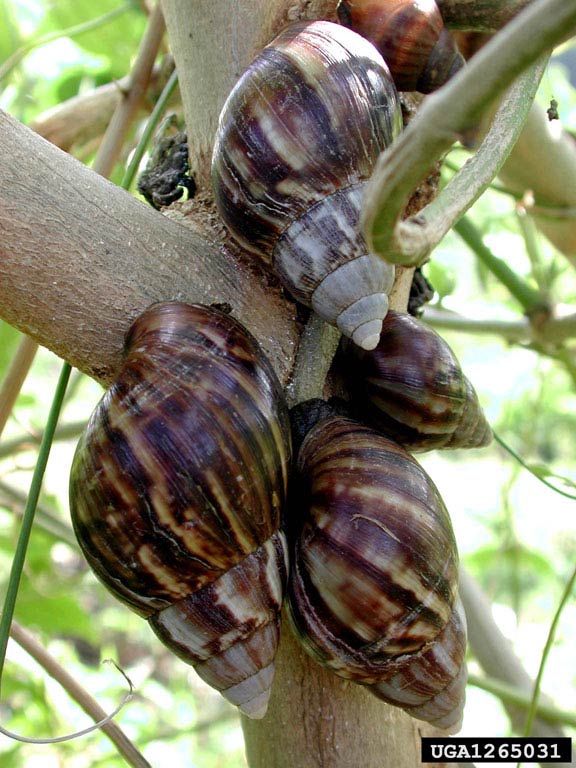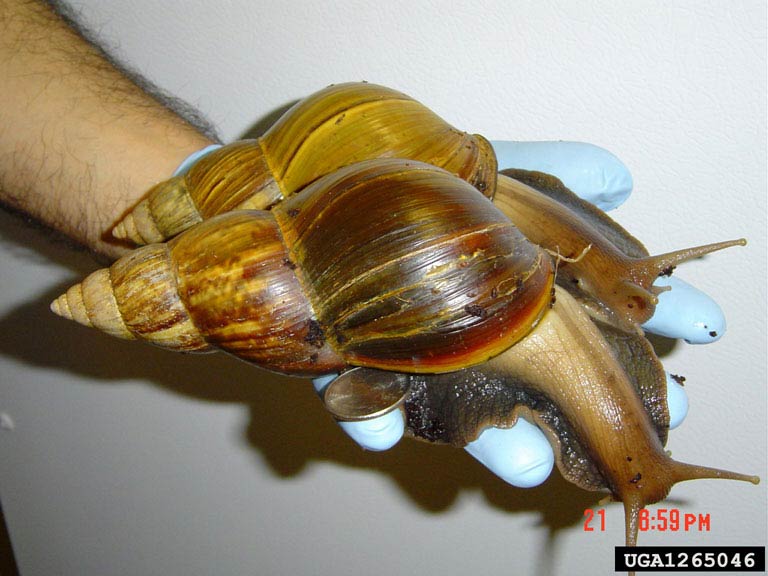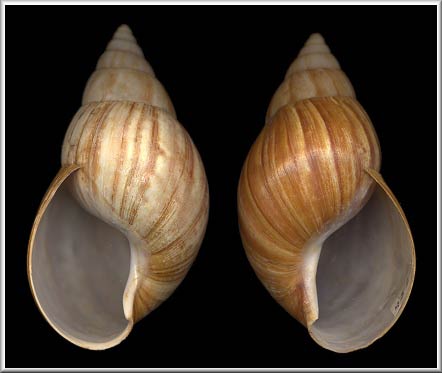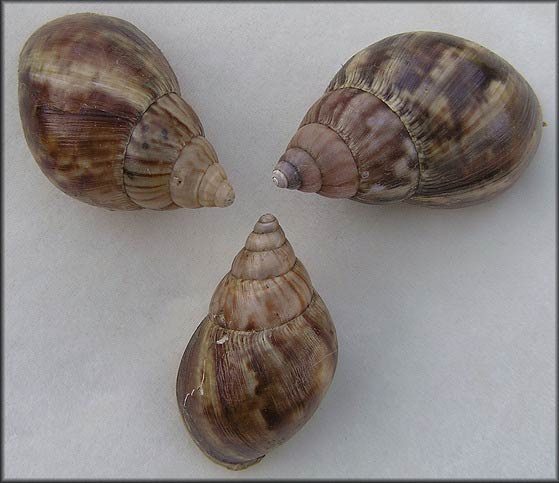Lissachatina fulica
|
Achatina (Lissachatina) fulica. (Photo: © D. Robinson, USDA-APHIS-PPQ) |
|
Achatina (Lissachatina) fulica. (Photo: © R. Zimmerman, USDA-APHIS) |
|
Achatina (Lissachatina) fulica. Sinistral (left) and Dextral (right). (Photo: © H.G. Lee, Jacksonville) |
|
Achatina (Lissachatina) fulica Achatina fulica. (Photo: © B. Frank, Jacksonville) |
|
Eggs of Achatina (Lissachatina) fulica. (Photo: © D. Robinson, USDA-APHIS-PPQ) |
Family
Achatinidae
Species
Lissachatina fulica (Bowdich, 1822)
Common name
Giant African snail, Achatine, Escargot geant, Caramujo
Description
Lissachatina fulica, also known as Achatina fulica is a large snail. The shellShell:
A hard, inflexible, calcareous or chitinous structure that vary in size and may either completely encasing the animal, covering some part of it or be internal.
of this species is generally narrowly conic with 7-10 whorlsWhorls:
Pleural of whorl. A whorl is a complete spiral turn/growth of the shell of a mollusc. The whorls are counted from the apex outwards.
and may attain a length of 200 mm (averaging 50-100 mm) and a widthWidth:
The width of the shell is the maximum distance across the shell (including the aperture).
of 120 mm when fully mature. The color pattern of the shell will vary widely depending on the diet of the animal but will most often consist of alternating bands of brown and tan. The body of the animal is brown-gray in color and it may be able to extend up to 300 mm in length.
Native range
East Africa
Distribution
North America: U.S.: Florida (invasive-eradication program implemented)
South and Central America: Argentina, Brazil (Sao Paulo, Rio de Janeiro, Minas Gerais), Ecuador, Venezuela
Indian Ocean: Madagascar, Mauritius, Seychelles
Pacific Islands: Hawaiian Islands, Marianas, Bonin, Caroline Islands, Guam, Wake, Society Islands, Vanuatu, Cook Islands, American Samoa, Western Samoa, Micronesia
Caribbean: Guadeloupe, Martinique, St. Lucia, Barbados
Australasia: Bougainville, New Guinea, New Ireland, New Britain, Papua, New Caledonia
Asia: India, Ceylon, Bangladesh, Malaya, Taiwan, Vietnam, Surinam, Java, Bali, Sulawesi, Moluccas, Flores, Timor, Iran, Jaya, Thailand, Japan, Hong Kong, China
Africa: Ethiopia, Somalia, Mozambique, Morocco, Ivory Coast, Ghana, Annobon, Equatorial Guinea, Sao Thome, Madagascar
Ecology
Achatinids are generally nocturnalNocturnal:
Occurring or becoming active at night.
forest dwellers but have the potential to adapt to disturbed habitats. Concealed habitats are generally preferred; however, individuals may colonize more open habitats in the event of overcrowding. Achatinids often become more active during periods of high humidity (e.g., after rainfall); however, the occurrence of large numbers of individuals especially during daylight may indicate high population density.
Achatinids normally lay their calcareousCalcareous:
Consisting of limestone or calcium carbonate.
eggs in the soil, but they may be deposited under leaf litter or rocks. They feed on both living and dead plant material. In addition to being agricultural pests, achatinids can be a threat to public health as they act as a reservoir host of the rat lung parasites (Angiostrongylus cantonensis and A. costaricensis), which cause eosinophilic meningoencephalitis in humans. They can also be an unsightly public nuisance during periods of population explosion.
References
Abbott 1989Abbott 1989:
Abbott, R.T. 1989. Compendium of landshells. A full-color guide to more than 2,000 of the World’s terrestrial shells. American Malacologists, Inc., Melbourne, FL and Burlington, MA. pp. 240.; Barker 2002Barker 2002:
Barker, G.M. (Ed.) 2002. Molluscs as crop pests. CABI Publishing, Wallingford, UK. pp. 1-468.; Cowie et al. 2008Cowie et al. 2008:
Cowie, R.H., K.A. Hayes, C.T. Chuong, T.Tran and W.M. Meyer III. 2008. The horticultural industry as a vector of alien snails and slugs: widespread invasions in Hawaii. International Journal of Pest Management 54(4): 267-276.; Cowie et al. 2009; Meyer and Cowie 2010






